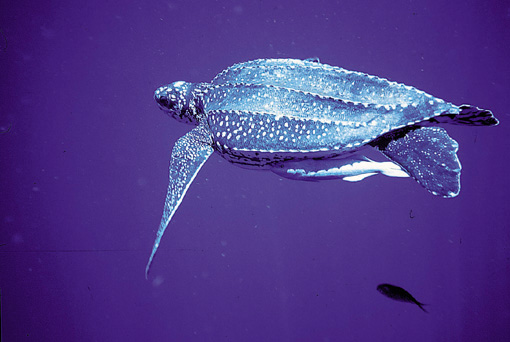When we think of sea turtles, our mind usually default to the loggerhead or the green, which have that typical “sea turtle look”. However, the leatherback sea turtle is often forgotten, in more ways than one. He is a little different than the rest you see, for several different reasons.

First of all, the leatherback is the only sea turtle in the Dermochelys genus. And to make matters more lonely, the leatherback is also the only remaining living member of the genus. It’s a lonely life when you’re the only one who survived since the Cretaceous period. It must be especially hard when they see the other sea turtles getting along like below:

Leatherbacks are also a lot more large and in charge than any other sea turtle. It is also the fourth largest modern reptile. So yes, the leatherback is bigger than other sea turtles, but how much bigger? And why? The second biggest sea turtle is the loggerhead (Caretta caretta), which is the largest of the hard-shelled turtles. The largest loggerhead was found to be 2.8m, although they tend to average around 0.9m. The leatherbacks average around 1.5m, and have the largest flippers in proportion to their body among the sea turtles and can have front flipper up to 2.7m in size. This shows that leatherbacks are quite a bit bigger than the second biggest, and it has been suggested that this helps them with thermoregulation because they are able to maintain high body temperatures even in the cold waters they migrate to. They also have much higher metabolic rates than other reptiles, which has been thought to be linked to their activity levels, as it is thought that they only spend about 0.1% of a day resting. They have counter current heat exchangers, insulating fat and a large size to allow them to migrate as far as they do.
The carapace of the leatherback is also very different to other sea turtles. I remember the first time I saw a leatherback I asked if it was a real turtle, because it just looked so completely different. Their tear drop shape makes them the most hydrodynamic of all sea turtles though, and they shel is actually leathery and has seven ridges instead of scutes. This all contributes to helping it be more hydrodynamic, which makes sense as they are migration record holders, the fastest swimming reptiles and one of the deepest diving marine animal. They might be very different and possibly a little bit forever alone, but these aspects of its physiology only allow it to be the coolest sea turtle, if you ask me.

Leatherbacks are solitary animals, and are usually only seen together in areas with a lot of jellyfish for feeding or during mating season. However, they quickly part ways and spend most of the time alone on the road during their 10,000 mile a year migrations. No other sea turtle does this, and so I think it is fair to say that the leatherback truly is a lonely giant, although whether or not they actually mind this or not remains to be seen.

